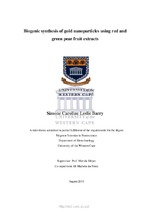| dc.contributor.advisor | Meyer, Mervin | |
| dc.contributor.author | Barry, Simone Caroline Leslie | |
| dc.date.accessioned | 2020-02-27T09:40:17Z | |
| dc.date.available | 2020-02-27T09:40:17Z | |
| dc.date.issued | 2019 | |
| dc.identifier.uri | http://hdl.handle.net/11394/7166 | |
| dc.description | >Magister Scientiae - MSc | en_US |
| dc.description.abstract | There has been a growing interest in the design of biocompatible and environmentally affable nanoparticles (NPs) among scientists to develop novel and safe biomaterials for use in various biomedical applications. This can be obtained through the use of plant and/ or fruit-derived phytochemicals that are capable of reducing gold ions into gold nanoparticles (AuNPs). Several studies have shown that different plant and fruit extracts possess different pharmacological properties as a result of their phytochemical profile and are capable of synthesising AuNPs with potential applications in medicine. Pears possess a unique phytochemical profile and these phytochemicals vary in the different parts of the pear and allows pears to exhibit beneficial pharmacological activities such as antioxidant, antimicrobial, anticarcinogenic as well as anti-inflammatory properties. Anthocyanins are important pigments responsible for the colouration of fruits but also have multiple uses in traditional Chinese medicine. Anthocyanins are strong antioxidants and since these molecules are present in pears, they could possibly be able to reduce gold (III) chloride to form NPs. The red-coloured ‘Bon Rouge’ pear contains higher levels of anthocyanins in comparison to the green-coloured ‘Williams Bon Chretien’ pear of which it is a mutant bud. A comprehensive study of the capability of the ‘Williams Bon Chretien’ and ‘Bon Rouge’ pears as the novel materials for the biogenic synthesis of AuNPs was conducted. Differences in the physicochemical properties of these AuNPs and potential biological applications based on the influence of anthocyanins and other phytochemicals within the pears were also explored. In addition, the effect of reaction temperature and extract concentration as well as kinetics as a function of time on the synthesis of AuNPs were conducted. The synthesized AuNPs were characterised for their size, polydispersity, morphology, crystallinity, active functional groups and in vitro stability. | en_US |
| dc.language.iso | en | en_US |
| dc.publisher | University of the Western Cape | en_US |
| dc.subject | Anthocyanin | en_US |
| dc.subject | Antimicrobial activity | en_US |
| dc.subject | Cytotoxicity | en_US |
| dc.subject | DLS | en_US |
| dc.subject | FTIR | en_US |
| dc.subject | Gold nanoparticles | en_US |
| dc.subject | Green flesh (GF) | en_US |
| dc.subject | Green peel (GP) | en_US |
| dc.subject | Green synthesis | en_US |
| dc.subject | HRTEM | en_US |
| dc.subject | Nanotechnology | en_US |
| dc.subject | Pear (Pyrus communis L.) | en_US |
| dc.subject | Phytochemicals | en_US |
| dc.subject | Red flesh (RF) | en_US |
| dc.subject | Red peel (RP) | en_US |
| dc.subject | UV-Vis Spectroscopy | en_US |
| dc.title | Biogenic synthesis of gold nanoparticles using red and green pear fruit extracts | en_US |
| dc.rights.holder | University of The Western Cape | en_US |

